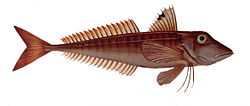Red gurnard
| Red gurnard | |
|---|---|
 | |
| Scientific classification | |
| Kingdom: | Animalia |
| Phylum: | Chordata |
| Class: | Actinopterygii |
| Order: | Scorpaeniformes |
| Family: | Triglidae |
| Genus: | Chelidonichthys |
| Species: | C. cuculus |
| Binomial name | |
| Chelidonichthys cuculus (Linnaeus, 1758)[1] | |
| Synonyms | |
| |
The Red gurnard, also East Atlantic red gurnard (Chelidonichthys cuculus) is a fish species of Triglidae family. Widespread in the Eastern Atlantic from British Isles (occasionally Norway) to Mauritania (including Madeira and Azores). Also known throughout the Mediterranean and possibly in the Black Sea.
Description
Gurnards are very distinctive bottom-living fish with large heads and eyes. The head is protected by large bony plates and strong spines. The lower three rays of the pectoral fins are separate, finger-like processes that contain sensory organs. These are used by the gurnard to 'feel' for small fish, crustaceans and other invertebrates living in the sediment. The red gurnard has a stout body, large head and eyes and moderately large scales. It is one of the smallest of the European gurnards reaching a maximum length of 40 cm (16 in). The coloration is bright red with pinkish-silver mottling on the sides and head. The protective bony plates on the head which are characteristic of all gurnards are very conspicuous in this species. Along the lateral line there is a row of large, plate-like scales. The divided dorsal fin has nine spines and seventeen to eighteen soft rays while the anal fin has no spines and sixteen to eighteen soft rays.[2]
Distribution and habitat
The red gurnard is native to the temperate eastern Atlantic Ocean and the Mediterranean Sea. Its range extends from southern Norway and Sweden southwards to the British Isles, France, Spain, Madeira, the Azores and the coast of Africa as far south as Mauritania. It is also present in the Mediterranean Sea and possibly the Black Sea. Its depth range is from the surface down to about 400 m (1,312 ft) but it is most usually found between 30 and 250 m (98 and 820 ft). It is found over sand, shingle or rocky seabeds and feeds on bottom-dwelling invertebrates, such as crustaceans, and also small fish.[2]
References
- ↑ Bailly, Nicolas (2013). "Chelidonichthys cuculus (Linnaeus, 1758)". World Register of Marine Species. Retrieved 2013-12-23.
- ↑ 2.0 2.1 "Chelidonichthys cuculus (Linnaeus, 1758): Red gurnard". FishBase. Retrieved 2013-12-23.
| Wikimedia Commons has media related to Chelidonichthys cuculus. |